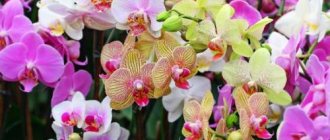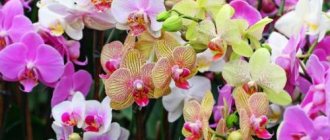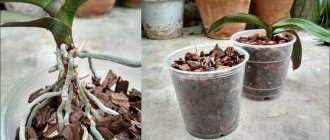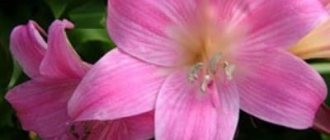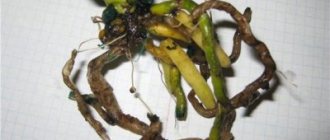The orchid does not bloom, what to do to make it bloom. Reasons for absence
After flowering, phalaenopsis, like other indoor flowers, enters a period of rest.
During this time, the standard restores lost strength and gains new ones. Next comes a period of active growth, when the flower can expel a couple of young leaves and a new peduncle.
If an orchid does not bloom for a long time at home, it is worth thinking about the reasons for this phenomenon.
The period during which the peduncle should appear is different for each variety; in some phalaenopsis it appears along with the leaf, and some expel it after the leaf blade has fully developed.
Young phalaenopsis peduncle.
Usually the reason that an exotic beauty does not bloom are:
- transferred stressful condition, in which even damage to the plant is possible. Stress for an orchid means a sudden change in the environment; this usually occurs when moving or when transporting a standard from a store to home during the cold season. In this case, it is possible to get frostbite or simply hypothermia of the plant;
- diseases will get in the way of flowering if the roots or leaves are affected. The plant simply does not receive enough necessary nutrients and will not be able to produce a high-quality peduncle. Shtamb simply does not have enough strength;
- poor care will also not accompany variegated flowers, only normal watering with a sufficient amount of fertilizer. A place without drafts, bright, but without direct sunlight, will promote the growth of the peduncle and the further development of flowers on it.
In addition, the lack of flowering may also be caused by improper proximity of plants, which should be strictly observed.
Advice! You should not grow banana trees and tomatoes on the same windowsill or near phalaenopsis. In the summer, protect the trunk from being close to apple and walnut trees.
When to expect flowering?
Attention : When should an orchid bloom - there is no definitive answer to this question. The time and duration of flowering depends on the experience and ability of the owner to provide the phalaenopsis with the environmental conditions necessary for flowering.
On average, an orchid blooms for about 3 months . Some particularly talented orchid growers manage to extend this period to 5 or even 8 months. Then the plant enters a dormant period and gains strength for new flowering. The flowering and resting cycle of each plant is different, so there is no exact data on when exactly the plant should release a peduncle and decorate the window.
Proper care of the plant can shorten the rest period as much as possible. Phalaenopsis can bloom almost all year round if it receives enough water, nutrients and light, as well as the right temperature. If we are talking about the first flowering of a young plant, then you do not need to wait for it earlier than 2 years after planting.
The orchid has released a peduncle, but is not blooming. Step-by-step instructions on how to care if there is no flowering
Option No. 1: Let's look at how to care for an orchid if it does not produce a peduncle and leaves and roots do not grow.
When there is no growth and flowering of an orchid, the reason may lie in systematic and frequent watering, and the absence of differences between day and night temperatures. To solve this problem you need:
- Place the pot on a windowsill where there is bright light but no direct rays.
- Water the flower once every 10–12 days after thoroughly drying the soil.
- Provide orchids with a difference in night and day temperatures of 5 - 7 degrees.
Option No. 2: When the orchid only grows roots, but no buds appear.
If there is no leaf growth and no flowering of the orchid at the same time, then the reason is regular, frequent watering and equal day and night temperatures. To solve this problem, you must follow the following recommendations:
- Place the pot on a windowsill where there is bright light but no direct rays.
- Watering should be done once every 10 – 12 days.
- In between waterings, thoroughly dry the soil.
- You also need to ensure that the orchid has a difference in night and day temperatures of 6-8 degrees.
Option No. 3: If the orchid produces only leaves, but not flower stalks.
Active vegetative growth of leaves and lack of flowering indicate an excess of nitrogen fertilizers in the soil. To solve the problem, it is important to spend a dry season for the flower.
- Allow 4 days between waterings to allow the roots to dry out.
- Stop spraying and fertilizing until the flower stalk appears.
- Organize proper lighting, add cold light lamps in winter. Keep them at a distance of 40 cm from the top of the head.
Artificially create a lack of moisture and ensure the temperature is around 30 degrees. After 1 – 2 months, flower buds will appear.
If the “drought” is carried out correctly, the peduncle will begin to actively grow, and the lower leaves will become softer.
Option No. 4: The orchid has released a peduncle, but still does not bloom.
If an orchid has released a peduncle, but only leaves and roots are growing, and still does not bloom, do not panic. This is an individual feature of many varieties, when the plant gains buds, but does not bloom them for up to 3 months.
What to do and how to force it?
If the peduncle has grown, but buds still do not appear on it, the problem lies in the following:
- Excessive watering. Or water got into the leaf outlet when watering.
- Increased concentration of fertilizers or their frequent application.
- A sharp change in growth conditions (often happens when a plant is brought home from a store).
- A sharp change in temperature, after which the culture fell into hibernation.
- Lack of lighting.
There are several proven ways to stimulate the appearance and blooming of buds.
The difference between night and day temperatures
This is one of the most important conditions for flowering. At a constantly high temperature, the orchid will only grow green mass, and the arrows will not appear.
If the grower provides the crop with a temperature difference, but flowering does not begin, then the difference needs to be increased by another couple of degrees.
After 10–14 days of new conditions, the phalaenopsis should bloom.
Feeding
When choosing fertilizers for an orchid, you need to give preference to those that contain the least nitrogen. The optimal ratio of potassium, phosphorus and nitrogen is 6:6:2.
Also, to stimulate flowering, a solution based on succinic acid is prepared, which is used to treat the leaf plates and roots of the plant. Cytokinin paste is well suited for processing. It not only stimulates flowering, but also restores weakened plants.
Warm shower
The procedure will not only speed up the appearance and blooming of buds, but also harden the plant. The manipulation is as follows:
- water the soil with settled water at room temperature;
- cover the substrate with polyethylene so that water from the shower does not fall on it;
- water the green part of the plant with warm water (temperature 40-50 degrees) for 20-25 seconds;
- then leave the phalaenopsis in the bathroom to cool.
The procedure is repeated several times with an interval of 10 days. In winter, warm showers are not allowed.
Transfer
Perhaps the plant has long needed a new pot. It is selected according to the volume of the root system: the pot should be several centimeters larger. A transparent container is required so that the roots take part in the process of photosynthesis. See step-by-step transplant instructions here.
It is also recommended to change the soil when replanting. Perhaps the old one has become impoverished and does not nourish the culture enough.
Forced drought
The option is suitable for any time of year and any temperature. The stimulation process will take approximately 2 months. To implement the method, it is necessary to significantly increase the intervals between soil moisture. It is necessary to wait until the substrate and roots are completely dry and wait another 4-6 days depending on the air temperature.
At this time, do not fertilize or spray the phalaenopsis. There is no need to be afraid that the plant will die: nothing bad will happen to it in such a relatively short period. As soon as the buds appear, you can return to your usual watering schedule.
If the stimulation process occurred in autumn or winter, it is important to provide the culture with additional lighting. It is advisable to use special phytolamps.
Phalaenopsis orchid does not bloom, what to do? Analysis of orchid keeping conditions
When buying a flower, you need to ask a specialist for an explanation of what variety it is and the characteristics of its cultivation. Phalaenopsis orchid, the most unpretentious variety that tolerates light shading. But there are orchids for which a south window is suitable, and even summer heat is tolerated well by them. An orchid does not bloom if the conditions of its maintenance are violated.
You should always place a saucer of boiled water next to the orchid. Place a clove of garlic in the substrate.
If the flower was purchased in a store, and it was already blooming, and the arrow turned yellow, then the rest period can last up to a year. If the plant is grown from children, then it will take more than two years to wait for the first flowering. By this time, the root system will gain strength and the orchid will produce 5-6 leaves. Early flowering will weaken the beauty.
Why doesn’t an orchid bloom at home after transplantation? When should we expect the first arrow? The transplanted plant initially builds up its root mass within six months. Afterwards, aerial roots develop and leaves grow. Flower buds are formed in the axils. The initial period of plant development in favorable conditions contributes to the laying of a larger number of flower stalks.
Let us remind you how to properly maintain an orchid:
- The roots are well developed, green, some of them are located on the walls of the transparent pot, some are at the top, absorbing moisture from the air.
- The substrate does not contain fresh bark, sawdust or manure.
- It is better to keep the lighting diffused.
- The difference in day and night temperatures when planting flower stalks should be at least 5 degrees.
- Fertilizing with liquid fertilizers depleted in nitrogen once every 10 days before the arrow shoots.
The conditions for laying flower buds are listed, but biological requirements for the maintenance of orchids must be observed.
What to do if the orchid does not bloom or develop well? It will be necessary to provoke the release of the arrow. The aerial root and the arrow look the same at first. But the tip of the arrow is rounded, and at the root it is sharp, as in the photo.
Useful video
We recommend watching a video about the reasons why phalaenopsis does not bloom and ways to make it produce buds again:
At home, phalaenopsis pleases with beautiful flowers almost all year round. After flowering comes the so-called dormant phase. It is during this period that experienced flower growers prune the peduncle.
Why doesn't an orchid bloom for a long time? Why doesn’t an orchid bloom at home and what to do about it?
Growing orchids is inextricably linked with the anxious anticipation of their flowering. During this period, plants become unusually spectacular, revealing their exotic beauty to the fullest. However, it often happens that for one reason or another, capricious tropical flowers do not bloom. Sometimes the duration of “flower silence” is calculated in years. For what reasons may orchids not bloom at home, what needs to be done to correct the situation?
Why doesn't the orchid bloom?
Flowering time, its frequency and duration depend on the characteristics of the plant variety. Most varieties begin to form the first buds at the age of 1.5-3 years. To determine the age of an exotic plant, it is necessary to count the number of shoots in its rosette - for example, two-year-old plants have at least 5 of them. Orchids usually bloom once every 2-3 months. Proper care and care of the plant ensures its flowering 2-3 times a year. Experienced plant growers claim that if an exotic plant does not form flowers for more than a year, then this clearly indicates the presence of some kind of problem.
At the same time, plants that stubbornly do not bloom can feel quite at ease. They produce new leaves, roots grow, and even flower stalks form. However, the formation of buds on peduncles does not occur. It even happens that an orchid can release a peduncle, which dies very quickly. The main factors due to which orchids do not form buds and bloom are:
- natural causes;
- improper care.
How and when to fertilize phalaenopsis
It is hardly possible to achieve abundant and long-lasting flowering with watering alone, without additional feeding. There are many ready-made preparations for caring for phalaenopsis on the market. Before choosing one of them, it is important to know some nuances about their composition and action.
Most orchid fertilizers include NPK nitrogen, phosphorus, potassium and trace elements. They differ from each other in the percentage of substances. For example, preparations with the highest nitrogen content are used during the period of active growth of leaves and roots. As soon as a peduncle appears, fertilizers that include this element are not used. It provokes excessive growth of green mass, and the plant does not have enough resources to form flower buds. During this period, you need to increase the amount of phosphorus and potassium.
Orchid, what to do if the orchid does not bloom. If the orchid does not bloom: what to do, what to do?
Everything written above sounds attractive, doesn't it? But, as they say, “it was smooth on paper, but we encountered ravines.” So it is in floriculture. It’s nice to read advice and look at colorful pictures of flowering plants on the pages of portals. But it’s worth listening to the advice and understanding for yourself what to do if orchids don’t bloom for a year or even longer. This situation is no longer normal and signals that something is wrong with your beauty. But what exactly is worth figuring out.
First, remember that in order for orchids to bloom, they need to create the appropriate conditions:
- the root system must be able to provide complete photosynthesis; for this, part of the roots must be above the pot to absorb excess lag from the surrounding air, and the lower roots are placed on the sides of a special substrate in a transparent plastic or glass pot;
- the soil should not contain fresh sawdust, fresh bark or, God forbid, fresh manure - all these substances make it impossible to plant and release a peduncle;
- lighting should be diffused - under direct sunlight, the root system dies and dries out;
- the ambient air temperature should have a daily difference of 5 degrees Celsius - at night it is necessary to move the pot with the plant to a cooler place (in winter you can get out of this position by moving the orchid to the central heating radiator and away from it, but constant spraying with warm water is necessary) ;
- fertilizing should be carried out at least once every 10 days.
Everything seems to be done, but the orchid still doesn’t bloom: what to do in this case? You may need to apply some tricks that professional flower growers use. We'll talk about this further. In the meantime, it would be a good idea to learn how to replant an orchid correctly.
What to do when the orchid has bloomed
Unfortunately, the orchid will not be able to bloom forever - as we have already found out, flowering is the period preceding reproduction
Therefore, when phalaenopsis fades at home, it is important to take care of the plant, providing it with good conditions for a dormant period
The question often arises regarding the need to trim the peduncle. There is no clear answer here. The plant either immediately dries it out or leaves it for the baby to develop. Of course, a dried peduncle is useless and has a completely unaesthetic appearance. Therefore, you can safely remove it and wait for a new flowering.
As for the living peduncle, there is no need to cut it off completely. There are three options for further developments:
- the orchid will release a side shoot and new flowers will bloom on it;
- the plant will grow a baby, so the peduncle is needed to nourish it;
- the phalaenopsis itself will dry out the stem it does not need.
In any case, it is necessary to trim the peduncle a little. For this you will need:
- Sharp tool: scissors, guillotine or stationery knife.
- Alcohol and cotton wool for sterilizing instruments.
The orchid does not bloom. Why don't orchids bloom?
Many amateur flower growers do not understand why their orchid has not bloomed for a year or 2 years. Let's take a closer look at the main question: why don't orchids bloom and what to do at home if a problem arises?
Care errors
The duration and frequency of flowering of an orchid depends both on the conditions of its maintenance and on its belonging to a particular species or variety.
If not properly cared for, the orchid will not bloom.
Hybrid varieties adapted for growing at home are characterized by cyclical flowering up to 2-3 times a year with breaks for rest. Violation of this rhythm indicates mistakes made when caring for the plant, resulting in non-flowering orchids.
Temperature violations
The homeland of orchids is humid and warm tropical forests, so when kept indoors it is necessary to maintain the correct temperature regime:
- At temperatures above 25-30℃, plants intensively grow green mass and bloom poorly; in winter, the temperature should not fall below 16℃. The optimum temperature for an orchid is 20-24℃;
- The formation of peduncles is well influenced by daily fluctuations in day and night temperatures within the range of 5-7℃.
This corresponds to the natural life cycle of the plant, during which a safe flowering mechanism is launched.
Lighting nuances
One of the main factors that affects the development and flowering of an orchid is light. Incorrect lighting causes stress:
- The leaves stretch out, their color becomes lighter;
- Growth slows down and flowering stops;
- A peduncle does not form;
- Direct sunlight in summer causes burns on the leaves.
The plant is sensitive even to such nuances of lighting as turning the pot around or moving it to another place, which can cause the flowers to drop.
Irrigation technique
Novice gardeners sometimes get too carried away with watering, which results in problems for the orchid:
- Frequent watering stimulates the development of vegetative parts: roots and leaves;
- Excessive moisture can cause roots to rot, causing them to become dark in color. This plant will not bloom.
The watering regime must be adjusted, and if rotten roots are found, the plant is transplanted into new soil.
Incorrect composition of fertilizing
An incorrectly selected fertilizer composition can be a factor due to which an orchid does not form a peduncle, for example, a variety such as cymbidium:
- Excess nitrogen stimulates the growth of the root system and leaves;
- Phosphorus in fertilizers stimulates the formation of peduncles.
Important ! For feeding, you need to use only special fertilizers for orchids with a low nitrogen content.
Before feeding orchids, make sure that the fertilizer contains the correct composition.
Above you can see a photo of what fertilizers for orchids at home from Bona Forte look like. The optimal ratio of nitrogen, potassium and phosphorus to stimulate flowering is 2:6:6.
After transplant
The roots of the plant are very sensitive to transplantation and take a long time to recover after it. The lack of flowering during this period may be due to the fact that:
- During the first half of the year after transplantation, the root mass actively grows. Then aerial roots form and leaves grow, in the axils of which flower buds are laid;
- If too many roots had to be removed during replanting, the flower may not adhere well to the substrate, which will make flowering difficult;
- Incorrect plant maintenance and growing conditions have a particular impact.
Comfortable conditions created after transplanting an orchid determine good growth, development and early flowering.
Violation of the root system
If the plant is transplanted incorrectly, damage to the root system is possible:
- Root rotting due to improperly selected substrate;
- The volume of the pot is too small for the root system;
- Injury to roots during transplantation due to their ingrowth into the walls of the pot.
If the transplant was carried out correctly, but flowering does not occur, a possible reason may be improper care of the orchid.
The soil does not support the plant
If an orchid is poorly anchored in the soil for a long time, this may affect its ability to form a peduncle. In this case, the plant must be transplanted into a suitable substrate or soil must be added to the pot.
Healthy
Sometimes an apparently healthy plant has problems with flowering: either the orchid does not bloom or quickly fades.
Fattens and does not produce a peduncle
The reasons for non-flowering can be different:
- Monotonous watering of the plant has a positive effect on leaf growth;
- Nitrogen predominates in fertilizing, and the orchid quickly increases its leaf mass.
Adjusting the watering and nutrition regime will help restore flowering.
Gives only children
Most likely, the temperature regime is not observed: during the day +22-24 degrees, at night +16-18 degrees. An excess of nitrogen in fertilizing is also possible.
If feeding is poor, the orchid does not bloom, but only produces babies.
Has released an arrow, but does not bloom
The orchid shoots, but the flower does not bloom for a long time. This is often due to uncomfortable growing conditions:
- If the peduncle appears in the dark season without additional lighting, the plant will not have the strength to flower normally;
- Low air humidity or close proximity of heating devices causes drying of the flower stalk.
With proper care and following the recommendations, the orchid will feel great at home and delight you with lush flowering.
The influence of diseases and pests on the development of peduncles
A plant affected by a fungal disease or insects (aphids, soft-bodied mites, scale insects, etc.) has stopped blooming, what to do in this case?
Attention! The main cause of orchid disease is weak immunity, a consequence of improper maintenance and care.
Treatment involves the use of fungicides or insecticides. After the recovery period, the plant will bloom again.
Drops flowers and buds
The reasons why an orchid sheds flowers and buds include:
- Old substrate that has already decomposed and rotted;
- Rearrangement to another location during flowering;
- A nearby air conditioner or cold draft;
- During flowering, the air temperature rose above 30℃;
- A flowering plant is not fertilized;
- You can only spray the leaves, not the flowers.
With proper care, the orchid will delight you with flowering for many years.
How to water phalaenopsis correctly
For normal growth and flowering, it is important to maintain optimal moisture in the nutrient substrate. Do not allow it to dry out, otherwise the orchids will stop absorbing nutrients. On the contrary, if you keep the soil mixture wet, this will lead to rotting of the roots and the development of diseases. A weakened plant will never bloom!
During different periods of the growing season, the frequency of watering varies:
- During the dormant period, when the plant requires a minimum of nutrients, watering is canceled . This usually happens immediately after the next flowering. At this time, it is important to give the plant a rest before active growth begins. On average, it lasts from two weeks to one month.
- Soon the formation of young leaves and roots begins. This process requires a lot of energy and moisture. As a rule, for phalaenopsis this period falls during the warm season from mid-spring to late summer. Then the plants are watered frequently, on average at least once a week.
Tip #1. In order not to make mistakes with the cleanliness of watering, you need to monitor the condition of the substrate. The next irrigation session is repeated when the soil mixture is completely dry from the previous one.
- As soon as the orchid has a new peduncle, the frequency of watering can be reduced to 12 - 15 days . This regime is maintained until the buds open.
- During flowering, plants are watered once every four days..
If, following these recommendations, the orchid still does not bloom, you can bathe it completely . To do this, immerse the pot in a large container with warm water and wash the plants completely, under the shower. In this case, the water temperature should be plus 40 degrees, and the pressure should be light and gentle, so that the strong stream does not damage the delicate leaves and roots of the orchid.
Bathing replaces tropical rains for orchids.
Sometimes phalaenopsis do not bloom because they are watered with cold water. The optimal irrigation temperature is +220 – +250. It’s even better if the water is 2-3 degrees higher than the air temperature.
One of the reasons why flower buds do not form is hard water. Excess salts are deposited in plant tissues and sap flow is hampered. This means that the normal course of growth and flowering is disrupted.
Elimination methods:
- Medium hard water can be optimized by filtration and settling. When watering, it is important not to stir up the sediment that settles at the bottom.
- If the water hardness is excessively high, it can be neutralized by adding citric acid. For one liter you will need several 5 - 7 crystals.
Citric acid is sold in grocery stores.
Important! You cannot water orchids with boiled water! At temperatures above 100 degrees, most of the nutrients needed by plants are destroyed.
The method of watering is also important. Irrigation of phalaenopsis has its own characteristics.
- Most often, the orchid is watered from a watering can with a thin spout . Do not pour water on the base of the leaves. The spout of the watering can is directed so that the water flows down the inner walls of the pot and does not fall on the leaves. If moisture lingers in the mouths, this will lead to their rotting.
- For the same reason, they try not to spray . The accumulation of water in the bends of ground organs makes it difficult to form flower stalks and buds. Such a plant will not be able to bloom.
- One of the watering methods is immersion . To do this, warm water 400 is poured into a larger container. Place a pot with an orchid in it for 15-20 minutes. After the plant is removed, you must wait until the excess water drains. Only after this they return to their place.
Why doesn't the orchid bloom, but only leaves and roots grow?
To establish the reason for the lack of flowering, you need to know the basic rules of care and external signs of a healthy orchid.
State of the root system
The development of the root system is closely related to the state of the above-ground part of the orchid. No matter how many aerial roots a plant has, it is important that they look healthy. By the appearance of the roots you can judge what the plant lacks:
- darkening of the roots is a sign of waterlogging and rotting;
- the appearance of a large number of aerial roots – increased dryness in the room.
Normally, the growing root tips are bright light green in color. If they are not visible for several months, it is necessary to reconsider the care of the plant.
Healthy root system.
Substrate composition
Fresh bark, sawdust or manure does not contribute to the emergence of a peduncle. Unlike other indoor plants, orchid roots are not able to absorb nutrients from the soil, so they need a specially selected substrate.
Important! An incorrectly selected mixture will cause waterlogging and rotting of the roots, in which case the plant will not bloom.
The composition of the substrate for orchids usually includes:
- pieces of pine bark;
- inert material (foam balls, expanded clay);
- sphagnum moss.
Substrate for orchids.
Sometimes other components are added to it. The following should be taken into account:
- fresh bark can be a source of infection, causing the plant to become sick. Before use, pieces of bark are boiled for 1 hour in order to get rid of pests and microorganisms, as well as resin residues;
- sawdust cannot be added to the substrate, as it consists of very small particles, which stick together when watered and disrupt the aeration of the roots;
- manure contains too many mineral and organic substances that are harmful to orchid roots.
A properly selected substrate is the key to the health and regular flowering of an orchid.
Lighting
Light is one of the main conditions for the good development and flowering of an orchid. If the lighting is chosen incorrectly, this will affect the condition of the plant:
- the leaves stretch out and become lighter;
- growth slows down and flowering stops;
- a peduncle does not form;
- Direct sunlight in summer causes burns on the leaves.
Even unwrapping the pot or moving it to another location can cause stress, resulting in a lack of flowering.
For regular orchid flowering you need:
- a large amount of diffused light;
- in the autumn-winter period, daylight hours are extended to 12 hours using a special phytolamp.
Insufficient duration of lighting in winter is the main factor due to which an indoor orchid does not form a peduncle.
Daily temperature difference, optimal temperature day and night
In nature, orchids grow in tropical forests, so in indoor culture, moist and warm cultivation conditions are most suitable for them:
- in summer, the optimal temperature in the apartment is 15-30℃, in winter – 20-23℃;
- The formation of a peduncle is stimulated by daily fluctuations in day and night temperatures within 5-7℃, which allows the plant to safely turn on the flowering mechanism.
In summer, such a natural temperature difference is created when growing an orchid on the balcony.
In summer it is recommended to grow orchids on the balcony.
Top dressing
Lack of flowering may be a consequence of improper feeding with an unbalanced fertilizer composition.
Attention! If there is good growth of the roots and leaves of an orchid, but the plant does not bloom, the most likely reason is the increased nitrogen content in the fertilizer.
Conventional phosphorus-potassium fertilizers are not suitable for feeding this plant. It is better to use special fertilizers for orchids with a low nitrogen content:
- fertilizing is applied only during the period of vegetative growth;
- Before fertilizing, water the plant so that the fertilizer does not cause burns to the roots;
- in the winter months, as well as in summer at temperatures above 24℃, fertilizing is applied once a month, in spring and autumn - once every two weeks.
- A plant that is in the leaf and root growth stage has a greater need for nitrogen.
- When forming flower-bearing arrows - in phosphorus and potassium.
How to care for a beautiful orchid during flowering
The orchid is native to the tropics. It survives both droughts and high temperatures with plenty of moisture. After the rains, the plant begins to powerfully grow leaves and roots, accumulate strength, and only then blooms. For an orchid, such indicators as proper lighting, humidity, and temperature are very important.
Choosing the right lighting for flower growth
Each type of orchid is individual. As for the Phalaenopsis orchid, it prefers bright, diffused light without direct sunlight. A great place for it would be the window sill of an east window.
Phalaenopsis loves bright light without direct sunlight
On a south or west window, the orchid should be separated with a tulle curtain. The length of daylight is also important, which should be at least 12 hours.
In a bright room with south-facing windows, the orchid can be placed not near the window
How humidity and watering affect the roots and growth of orchid arrows
Watering an orchid is done by immersing the pot in a bucket of water or a deep tray. The roots and soil should be allowed to soak for about 30 minutes and excess water should be drained. It is useful to spray the upper part of the substrate with a spray bottle. During the rest period, orchids are watered less often - only after the roots of the plant change their green color to grayish. In dry climates it is important to maintain high humidity around the orchids, this can be achieved by placing the pot on a tray of damp expanded clay. In this case, it is very important that the pan is wide and the evaporation area is large.
A humid atmosphere should be maintained around orchids.
Choosing the right temperature for orchid growth and flowering
It is believed that temperature changes can stimulate the flowering of orchids. It is enough that the daytime temperature differs from the nighttime temperature by 3–5 degrees. It is quite possible to do this on a window. The optimal temperature for orchid growth in summer is 25–30 degrees; in winter, plants can be kept at 18 degrees.
Table: lighting, temperature and watering have a great influence on the growth and flowering of different varieties of orchids
| Orchid variety | Location and lighting | Daytime temperature | Watering frequency |
| Phalaenopsis Orchid | The plant can be installed on western and eastern window sills. | 18–25 ºC | Typical humidity is 30–40%. Watering is carried out after the soil has completely dried. |
| Dendrobium Orchid | Flowers are suitable for good lighting, but without direct sunlight in the afternoon. | 15–25 ºC | Optimal humidity is 25–30%. An increase in humidity gives rise to new shoots. |
| Orchid Cymbidium | The plant needs a lot of fresh air and light. The flower can be exposed to open sun for at least four hours a day. Bright but soft autumn sun is the best “helper” for flowering. | Withstands temperatures of 35–38 °C | During the period of active growth, it requires abundant watering. It is necessary to allow the soil to dry out between waterings. |
| Orchid Paphiopedilum | Does not like bright sunlight. When exposed to direct sunlight, burns appear on the leaves. Flowers will take root on northern windows, but the eastern direction is also suitable. | 18–25 °C | Needs abundant and frequent watering. Excess water must flow out through the drainage holes of the pot. |
Flowering rules
In order to know whether your orchid is blooming correctly or not, you need to familiarize yourself with the main rules of its flowering
One of the most important questions that you have probably asked yourself more than once in the process of caring for this type of orchid is: how long does phalaenopsis bloom? It is important to note that everything here very much depends on the characteristics of the conditions of detention and the variety. On average, phalaenopsis blooms from two to six months
The frequency of flowering depends on the same factors as the flowering period, but most often flowering occurs 1 or 2 times a year. In any case, if the maintenance conditions are properly observed, phalaenopsis is guaranteed to bloom at least once a year. Another important rule that you need to know is that the phalaenopsis orchid is a perennial plant. In indoor conditions, its life expectancy with proper care is on average 7-10 years.
Reasons for non-blooming phalaenopsis orchids
As we have already said, quite often there are times when your phalaenopsis simply stops blooming for a long time. You may not notice it at first, but week after week, when the plants remain without flowers, you will definitely become suspicious. The main thing is not to fuss and not to rush to throw away a non-flowering phalaenopsis, because everything can be corrected by simply finding the correct reason for the non-flowering and eliminating it.
The main reasons for the absence of peduncles in phalaenopsis are:
- Improper watering, namely, insufficient drying of the plant between waterings. Watering rules for phalaenopsis are quite important; if you water it like a salad, sprinkling water or simply watering it from above so that the water flows down, doing this once a week, then it goes without saying that your orchid will not feel great. For phalaenopsis, it is more important to have the necessary and constant source of moisture, which can be a tray of water placed under a flowerpot, providing the phalaenopsis with sufficient moisture so that direct watering can be reduced;
- No natural temperature difference. Also, one of the keys to the health of your orchid is the correct temperature regime, which includes ensuring a sufficient temperature difference, that is, 3-4 degrees per day. In the summer season this most often happens by itself, but in the winter you need to be more careful, doing everything to ensure that there is the necessary difference between day and night temperatures;
- Excessive use of fertilizers. It often happens that illiterate sellers advise you on the wrong dosage of fertilizers, which speeds up the growth of phalaenopsis, but there is no energy left for flowering and, thus, the entire plant cycle is disrupted. Advice in such a case is that it is better to stop using fertilizers for a certain period and water the orchid with plain clean water.
How to Make a Phalaenopsis Orchid Bloom
Do not change the location of the flower, as this will help avoid unwanted stress on the plant, especially during the period when it is preparing to bloom. Determine the age of your phalaenopsis and you will understand whether it is ready to bloom or not. With proper development, the flower begins to bloom in the period from 1.5 to 3 years. This can be determined simply by counting the leaves, since phalaenopsis
which is ready to bloom, usually has 5-8 mature shoots. Pay special attention to the roots of phalaenopsis, which are directly involved in photosynthesis. For them, it is necessary to create conditions under which light can easily fall on them, that is, the best option is to place them in a plastic pot that easily transmits light; Provide full access to bright light to your plant
If there is not enough natural light in autumn or winter, use special lamps to individually illuminate your phalaenopsis; Don't forget about the required temperature difference.
How to make phalaenopsis bloom again
If you want to make your orchid bloom again, then you need to use slightly different means. You need to create a stressful situation for the plant, for example, make a sharp jump in the temperature environment or suddenly stop watering, which will also affect its reaction and most likely lead to extraordinary flowering.
You can also read our other articles about this type of orchid:
- Care for Phalaenopsis
- Replanting Phalaenopsis
Optimal conditions for flowering
In order for the buds to bloom faster, you must follow a number of rules for caring for the flower.
It is important to maintain optimal temperature conditions. Some flowers can grow at temperatures of +50, and most varieties do not tolerate temperatures above +25
Therefore, before purchasing an orchid, you need to read more about the conditions under which it is kept. In addition, the flower does not tolerate temperature changes well.
Lighting has no less effect on the flowering of an orchid. In winter, the flower should be illuminated with halogen, fluorescent or mercury lamps up to 40 W. The orchid must receive lighting at least 14 hours a day. Do not place the pot next to radiators in winter.
The orchid should be watered while strictly observing the temperature regime in the apartment. Otherwise, the flower simply will not bloom due to stress. Water the delicate exotic only with water at room temperature. Some species growing in warm countries, on the contrary, prefer watering only with hot water no more than 45 degrees. But all varieties of domestic flowers should not be watered with cold water. Moisture from the roots should completely drain.
The flower feels comfortable at room humidity of at least 60%. Humidifiers help make the air moist; you can often wipe the leaves, wash them, or spray them with a spray bottle. Spraying is carried out with soft, settled water. You can use melt water. The smallest nozzle on the spray bottle should be used so that the moisture is sprayed in a cloud over the plant. Additional moisture is possible if the grower places a tray of water next to the pot.
Popular: Description and landscape design with feather grass plant
For an orchid, caring for the root system is important. If the roots die, the plant will simply wither
Therefore, it is so important to water the orchid correctly and provide the roots with good air exchange. If the plant is grown in a transparent container, this makes it easier to monitor the condition of its root system
Healthy roots have a green tint. With a lack of water they become whitish. Watering is done when the roots turn white. If they turn brown, it means the roots are rotting or drying out. You can use a root growth stimulator to feed the roots.
Why doesn't the orchid bloom?
How quickly the flower blooms may also depend on the age of the orchid. Perhaps it is too young, and the first flowers appear on an indoor pet after 1.5-3 years. A plant ready to flower will have five to eight shoots.
A moved pot can also be the reason why the plant does not gain color for a long time. The orchid perceives changes in lighting negatively. If you urgently need to move the pot, then you should leave the same side of the plant illuminated as before. It is better to grow in a transparent glass pot with holes in the bottom.
What conditions are needed for phalaenopsis to bloom?
In order for your exotic beauty to delight you with lush blooms, it is very important to follow the rules of care. Failure to comply with these rules in 100% of cases leads to fungal infections and the proliferation of parasites
So, what should you do to make the orchid bloom:
Phalaenopsis, and all other types of orchids, do not like changing places, so there is no need to change their position often, even in relation to the sun. The better the process of photosynthesis occurs in the roots, the more often new flower stalks are formed at the growth point. To do this, it is necessary to plant plants in transparent containers that allow light and air to penetrate. In the wild, orchids have about 16 hours of daylight.
Therefore, in winter, it is advisable to illuminate your tropical beauties with a special phytolamp. The air should not be allowed to dry out - this can lead to drying out of the soil and root system, as well as the proliferation of parasites. Of course, it is necessary to maintain the correct temperature regime, and it is important to provide the plant with a difference between day and night temperatures. During the day, the temperature norm can be from 22 to 25 degrees, at night 15-18 degrees. Unfortunately, there is no specific rule for watering - it all depends on the lighting, temperature, and dryness of the ambient air.
It is advisable to water some varieties rarely, allowing them to dry well. For others, such as mini phalaenopsis, prolonged lack of moisture can be fatal. It is also important to find your own method of watering: some do a spill, others moisten the substrate by immersion, others use a warm shower, and still others place it on a water cushion. Fertilize plants during the dormant period by adding phosphorus and calcium preparations. After the plant produces a flower stalk, water only with clean water, as fertilizers can speed up the plant's metabolism, and the flowering period will pass faster than usual.
For many gardeners, the topic of how to extend the flowering period of phalaenopsis is very relevant. Here, experienced orchid owners agree: if it blooms, leave the plant alone. Orchids do not like overprotection, so there is no need to inspect the leaves every day, look for spots, try to find parasites in the bark and touch the flowering branches with your hands. Constant care for your orchid is important, but everything is good in moderation. The less you interfere with the natural life cycle of the plant, the more the orchid will like it, and the longer it will please you.
Reasons why orchids do not bloom again
It happens that when a blooming Phalaenopsis is brought home, it holds the flowers for the allotted time. but after they wither, new buds do not appear either this year or the next. There may be several reasons for this:
- Violation of growing conditions,
- Lack or excess of water
- Incorrect feeding.
- Change of location.
Read more about what this leads to and how to eliminate the shortcomings.
Phalaenopsis comes for sale from greenhouses, where optimal conditions have been created that are as close to natural as possible. Changing your place of residence invariably affects the flowering of orchids. In order for them to bloom again, they need a special atmosphere.
Optimal conditions for phalaenopsis to produce flowering
In order for phalaenopsis to develop normally and bloom the maximum number of times for its variety (or hybrid), it needs to create a certain environment. It must meet the following characteristics:
Temperature varies depending on the growing season of the orchid. All vital processes occur most intensively within +20 – + 35. If the temperature is higher, the plant is not able to absorb a large volume of oxygen. High load disrupts the balance between respiration and photosynthesis. This negatively affects the formation of flowering organs; phalaenopsis no longer has enough strength to do this. At temperatures below +18, the formation of flower buds is impossible due to lack of heat. For the formation of flower stalks and future buds, it is necessary to ensure a difference between day and night temperatures within 3-5 degrees. Most often, for phalaenopsis that blooms in winter, such conditions are provided on windowsills under which there are radiators. In the summer, orchids need to be protected from the heat, otherwise they will struggle with discomfort instead of forming flowers.
Lighting The development cycles of phalaenopsis directly depend on light. For example, an orchid freezes in growth and goes into a dormant state when the length of daylight hours decreases in the fall. This can be determined by the thick white coating on the roots. This tissue is called velamen, it absorbs nutrients from the air. It is absent on young shoots, but is densest on dormant roots. The optimal lighting duration is 12 hours. If you add extra light to phalaenopsis in winter, you can get two or even three blooms throughout the year. That is, 365 days from the beginning of the first flowering. Perhaps this period will cross the next calendar year.
Humidity Phalaenopsis is a plant of tropical origin. For flowering at home, you need to create a range of 50% - 80%
If the indicators are lower or higher, the orchid may exist, but not form flowers. Aeration Free air movement is extremely important; when it stagnates, breathing processes are disrupted. However, orchids do not tolerate drafts
Because of this, they not only stop blooming, but may die.
The normal formation of the root system directly affects flowering: 1 - period of active growth; 2 - dormant state.
Violation of at least one of the conditions for growing an orchid can lead to a lack of flowering. Roots and leaves will grow, but flowers will not appear.
L. V. Kovalskaya – Candidate of Biological Sciences,
Art. n. Art. National Botanical Garden
them. N. Grishko.
